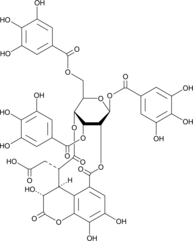Chemicals
Showing 14251–14400 of 41137 results
-
CGP 77675 is an inhibitor of Src family kinases (SFKs) that blocks the phosphorylation of peptide substrates and autophosphorylation of purified c-Src (IC50s = 5-20 and 40 nM, respectively).{33451} It also inhibits the SFKs Lck and c-Yes with low nanomolar IC50 values.{33451,33450,33453} CGP 77675 is used to elucidate the role of SFKs in such processes as bone resorption, tight junction formation in epithelial cells, and allograft survival.{33450,33451,33454} It can also be used in combination with the GSK3 inhibitor CHIR99021 (Item No. 13122) to maintain mouse embryonic stem cells.{33452}
Brand:CaymanSKU:21089 -Out of stock
CGP 77675 is an inhibitor of Src family kinases (SFKs) that blocks the phosphorylation of peptide substrates and autophosphorylation of purified c-Src (IC50s = 5-20 and 40 nM, respectively).{33451} It also inhibits the SFKs Lck and c-Yes with low nanomolar IC50 values.{33451,33450,33453} CGP 77675 is used to elucidate the role of SFKs in such processes as bone resorption, tight junction formation in epithelial cells, and allograft survival.{33450,33451,33454} It can also be used in combination with the GSK3 inhibitor CHIR99021 (Item No. 13122) to maintain mouse embryonic stem cells.{33452}
Brand:CaymanSKU:21089 -Out of stock
CGP 7930 is a positive allosteric modulator of GABAB receptors.{45680} It enhances GABA binding with a maximal effect of 143% compared to a GABA-only control in CHO cells membranes expressing the GABAB(1b/2) receptor and enhances GABA binding to rat cortical membranes when used at a concentration of 30 µM. It is selective for GABA binding to heterodimeric GABAB(1b/2) over monomeric GABAB(1b) receptors. CGP 7930 potentiates the efficacy of the GABAB receptor agonist baclofen (Item No. 27326) in decreasing the spontaneous firing rate of dopaminergic neurons in the rat ventral tegmental area (VTA) in vitro (EC50 = 0.27 µM).{45681} It also potentiates the sedative-reducing effects induced by the GABAB receptor agonists baclofen and γ-hydroxybutyric acid (GHB) in rats when administered at doses ranging from 10 to 170 mg/kg, effects that can be blocked by the GABAB receptor antagonist SCH 50911.{45682} CGP 7930 reduces self-administration of nicotine, alcohol, and cocaine in rodent models.{45683} It suppresses the acquisition of alcohol drinking behavior in alcohol-naïve Sardinian alcohol-preferring rats over a five-day period when administered at doses ranging from 25 to 100 mg/kg and transiently reduces the maintenance of alcohol drinking behavior in alcohol-experienced rats at a dose of 100 mg/kg.{45684}
Brand:CaymanSKU:29429 - 1 mgAvailable on backorder
CGP 7930 is a positive allosteric modulator of GABAB receptors.{45680} It enhances GABA binding with a maximal effect of 143% compared to a GABA-only control in CHO cells membranes expressing the GABAB(1b/2) receptor and enhances GABA binding to rat cortical membranes when used at a concentration of 30 µM. It is selective for GABA binding to heterodimeric GABAB(1b/2) over monomeric GABAB(1b) receptors. CGP 7930 potentiates the efficacy of the GABAB receptor agonist baclofen (Item No. 27326) in decreasing the spontaneous firing rate of dopaminergic neurons in the rat ventral tegmental area (VTA) in vitro (EC50 = 0.27 µM).{45681} It also potentiates the sedative-reducing effects induced by the GABAB receptor agonists baclofen and γ-hydroxybutyric acid (GHB) in rats when administered at doses ranging from 10 to 170 mg/kg, effects that can be blocked by the GABAB receptor antagonist SCH 50911.{45682} CGP 7930 reduces self-administration of nicotine, alcohol, and cocaine in rodent models.{45683} It suppresses the acquisition of alcohol drinking behavior in alcohol-naïve Sardinian alcohol-preferring rats over a five-day period when administered at doses ranging from 25 to 100 mg/kg and transiently reduces the maintenance of alcohol drinking behavior in alcohol-experienced rats at a dose of 100 mg/kg.{45684}
Brand:CaymanSKU:29429 - 10 mgAvailable on backorder
CGP 7930 is a positive allosteric modulator of GABAB receptors.{45680} It enhances GABA binding with a maximal effect of 143% compared to a GABA-only control in CHO cells membranes expressing the GABAB(1b/2) receptor and enhances GABA binding to rat cortical membranes when used at a concentration of 30 µM. It is selective for GABA binding to heterodimeric GABAB(1b/2) over monomeric GABAB(1b) receptors. CGP 7930 potentiates the efficacy of the GABAB receptor agonist baclofen (Item No. 27326) in decreasing the spontaneous firing rate of dopaminergic neurons in the rat ventral tegmental area (VTA) in vitro (EC50 = 0.27 µM).{45681} It also potentiates the sedative-reducing effects induced by the GABAB receptor agonists baclofen and γ-hydroxybutyric acid (GHB) in rats when administered at doses ranging from 10 to 170 mg/kg, effects that can be blocked by the GABAB receptor antagonist SCH 50911.{45682} CGP 7930 reduces self-administration of nicotine, alcohol, and cocaine in rodent models.{45683} It suppresses the acquisition of alcohol drinking behavior in alcohol-naïve Sardinian alcohol-preferring rats over a five-day period when administered at doses ranging from 25 to 100 mg/kg and transiently reduces the maintenance of alcohol drinking behavior in alcohol-experienced rats at a dose of 100 mg/kg.{45684}
Brand:CaymanSKU:29429 - 5 mgAvailable on backorder
CGS 12066B is an agonist of the serotonin (5-HT) receptor subtype 5-HT1B (IC50 = 51 nM).{53886} It is selective for 5-HT1B over 5-HT1A and 5-HT2 receptors (IC50s = 876 and 6,480 nM, respectively), as well as α1-, α2-, and β-adrenergic, and dopamine D1 and D2 receptors (IC50s = >6,000, >1,000, >1,000, >5,000, and >5,000 nM, respectively). CGS 12066B inhibits forskolin-induced cAMP accumulation in opossum kidney cells when used at concentrations ranging from 0.001 to 1 µM.{53887} In vivo, CGS 12066B reduces 5-hydroxy-L-tryptophan (5-HTP) accumulation in the fronto-parietal cortex (ED50 = 7.92 µmol/kg) and induces dorsal raphe cell firing in rats (ED50 = 358 nmol/kg).{53886} It decreases interfemale and intermale aggression in Syrian hamsters.{53888}
Brand:CaymanSKU:30623 - 10 mgAvailable on backorder
CGS 12066B is an agonist of the serotonin (5-HT) receptor subtype 5-HT1B (IC50 = 51 nM).{53886} It is selective for 5-HT1B over 5-HT1A and 5-HT2 receptors (IC50s = 876 and 6,480 nM, respectively), as well as α1-, α2-, and β-adrenergic, and dopamine D1 and D2 receptors (IC50s = >6,000, >1,000, >1,000, >5,000, and >5,000 nM, respectively). CGS 12066B inhibits forskolin-induced cAMP accumulation in opossum kidney cells when used at concentrations ranging from 0.001 to 1 µM.{53887} In vivo, CGS 12066B reduces 5-hydroxy-L-tryptophan (5-HTP) accumulation in the fronto-parietal cortex (ED50 = 7.92 µmol/kg) and induces dorsal raphe cell firing in rats (ED50 = 358 nmol/kg).{53886} It decreases interfemale and intermale aggression in Syrian hamsters.{53888}
Brand:CaymanSKU:30623 - 25 mgAvailable on backorder
CGS 12066B is an agonist of the serotonin (5-HT) receptor subtype 5-HT1B (IC50 = 51 nM).{53886} It is selective for 5-HT1B over 5-HT1A and 5-HT2 receptors (IC50s = 876 and 6,480 nM, respectively), as well as α1-, α2-, and β-adrenergic, and dopamine D1 and D2 receptors (IC50s = >6,000, >1,000, >1,000, >5,000, and >5,000 nM, respectively). CGS 12066B inhibits forskolin-induced cAMP accumulation in opossum kidney cells when used at concentrations ranging from 0.001 to 1 µM.{53887} In vivo, CGS 12066B reduces 5-hydroxy-L-tryptophan (5-HTP) accumulation in the fronto-parietal cortex (ED50 = 7.92 µmol/kg) and induces dorsal raphe cell firing in rats (ED50 = 358 nmol/kg).{53886} It decreases interfemale and intermale aggression in Syrian hamsters.{53888}
Brand:CaymanSKU:30623 - 5 mgAvailable on backorder
CGS 15943 is an orally bioavailable non-xanthine antagonist at adenosine (A) receptors with IC50 values of 3.5, 4.2, 16, and 51 nM in CHO cells transfected with human recombinant A1, A2A, A2B, and A3 receptors, respectively.{34118,39224} It also binds to the phosphatidylinositol 3-kinase (PI3K) catalytic subunit p110γ, and it inhibits proliferation of HCC hepatocellular carcinoma and PDAC pancreatic cancer adenocarcinoma cells through the PI3K/Akt signaling pathway.{39223} In rats, CGS 15943 (0.1-10 mg/kg, i.p.) increases locomotor activity in a dose-dependent manner.{39225} It also reinforces and reinstates cocaine-seeking in baboons through an adenosine-dependent mechanism.{39226}
Brand:CaymanSKU:22073 -Out of stock
CGS 15943 is an orally bioavailable non-xanthine antagonist at adenosine (A) receptors with IC50 values of 3.5, 4.2, 16, and 51 nM in CHO cells transfected with human recombinant A1, A2A, A2B, and A3 receptors, respectively.{34118,39224} It also binds to the phosphatidylinositol 3-kinase (PI3K) catalytic subunit p110γ, and it inhibits proliferation of HCC hepatocellular carcinoma and PDAC pancreatic cancer adenocarcinoma cells through the PI3K/Akt signaling pathway.{39223} In rats, CGS 15943 (0.1-10 mg/kg, i.p.) increases locomotor activity in a dose-dependent manner.{39225} It also reinforces and reinstates cocaine-seeking in baboons through an adenosine-dependent mechanism.{39226}
Brand:CaymanSKU:22073 -Out of stock
CGS 15943 is an orally bioavailable non-xanthine antagonist at adenosine (A) receptors with IC50 values of 3.5, 4.2, 16, and 51 nM in CHO cells transfected with human recombinant A1, A2A, A2B, and A3 receptors, respectively.{34118,39224} It also binds to the phosphatidylinositol 3-kinase (PI3K) catalytic subunit p110γ, and it inhibits proliferation of HCC hepatocellular carcinoma and PDAC pancreatic cancer adenocarcinoma cells through the PI3K/Akt signaling pathway.{39223} In rats, CGS 15943 (0.1-10 mg/kg, i.p.) increases locomotor activity in a dose-dependent manner.{39225} It also reinforces and reinstates cocaine-seeking in baboons through an adenosine-dependent mechanism.{39226}
Brand:CaymanSKU:22073 -Out of stock
CGS 15943 is an orally bioavailable non-xanthine antagonist at adenosine (A) receptors with IC50 values of 3.5, 4.2, 16, and 51 nM in CHO cells transfected with human recombinant A1, A2A, A2B, and A3 receptors, respectively.{34118,39224} It also binds to the phosphatidylinositol 3-kinase (PI3K) catalytic subunit p110γ, and it inhibits proliferation of HCC hepatocellular carcinoma and PDAC pancreatic cancer adenocarcinoma cells through the PI3K/Akt signaling pathway.{39223} In rats, CGS 15943 (0.1-10 mg/kg, i.p.) increases locomotor activity in a dose-dependent manner.{39225} It also reinforces and reinstates cocaine-seeking in baboons through an adenosine-dependent mechanism.{39226}
Brand:CaymanSKU:22073 -Out of stock
CGS 21680 is a potent, selective agonist of the adenosine A2A receptor (Ki = 11-46 nM).{27928,27924} It is less effective at adenosine A1 and A3 receptors (Kis = 0.5-3.1 and 0.6-1 µM, respectively) and is without effect at adenosine A2B (Ki > 10 µM).{27924,27925,27926,27927} CGS 21680 is commonly used to study the actions of the adenosine A2A receptor in cells and tissues.{11819,5049,27816}
Brand:CaymanSKU:-Out of stock
CGS 21680 is a potent, selective agonist of the adenosine A2A receptor (Ki = 11-46 nM).{27928,27924} It is less effective at adenosine A1 and A3 receptors (Kis = 0.5-3.1 and 0.6-1 µM, respectively) and is without effect at adenosine A2B (Ki > 10 µM).{27924,27925,27926,27927} CGS 21680 is commonly used to study the actions of the adenosine A2A receptor in cells and tissues.{11819,5049,27816}
Brand:CaymanSKU:-Out of stock
CGS 21680 is a potent, selective agonist of the adenosine A2A receptor (Ki = 11-46 nM).{27928,27924} It is less effective at adenosine A1 and A3 receptors (Kis = 0.5-3.1 and 0.6-1 µM, respectively) and is without effect at adenosine A2B (Ki > 10 µM).{27924,27925,27926,27927} CGS 21680 is commonly used to study the actions of the adenosine A2A receptor in cells and tissues.{11819,5049,27816}
Brand:CaymanSKU:-Out of stock
CGS 21680 is a potent, selective agonist of the adenosine A2A receptor (Ki = 11-46 nM).{27928,27924} It is less effective at adenosine A1 and A3 receptors (Kis = 0.5-3.1 and 0.6-1 µM, respectively) and is without effect at adenosine A2B (Ki > 10 µM).{27924,27925,27926,27927} CGS 21680 is commonly used to study the actions of the adenosine A2A receptor in cells and tissues.{11819,5049,27816}
Brand:CaymanSKU:-Out of stock
CGS 9343B is a calmodulin inhibitor.{54666,54667,54668} It inhibits calmodulin-induced phosphodiesterase (PDE) activity (IC50 = 3.3 µM) but does not inhibit basal PKC activity at 100 µM.{54667} CGS 9343B (120 µM) inhibits calcium release induced by inositol 1,4,5-trisphosphate (IP3) in 261B rat liver epithelial cells.{54667} It reduces the incidence of diarrhea without affecting gastrointestinal transit time in a mouse model of secretory diarrhea induced by castor oil when administered at a dose of 3 mg/kg.{54668}
Brand:CaymanSKU:32844 - 1 mgAvailable on backorder
CGS 9343B is a calmodulin inhibitor.{54666,54667,54668} It inhibits calmodulin-induced phosphodiesterase (PDE) activity (IC50 = 3.3 µM) but does not inhibit basal PKC activity at 100 µM.{54667} CGS 9343B (120 µM) inhibits calcium release induced by inositol 1,4,5-trisphosphate (IP3) in 261B rat liver epithelial cells.{54667} It reduces the incidence of diarrhea without affecting gastrointestinal transit time in a mouse model of secretory diarrhea induced by castor oil when administered at a dose of 3 mg/kg.{54668}
Brand:CaymanSKU:32844 - 10 mgAvailable on backorder
CGS 9343B is a calmodulin inhibitor.{54666,54667,54668} It inhibits calmodulin-induced phosphodiesterase (PDE) activity (IC50 = 3.3 µM) but does not inhibit basal PKC activity at 100 µM.{54667} CGS 9343B (120 µM) inhibits calcium release induced by inositol 1,4,5-trisphosphate (IP3) in 261B rat liver epithelial cells.{54667} It reduces the incidence of diarrhea without affecting gastrointestinal transit time in a mouse model of secretory diarrhea induced by castor oil when administered at a dose of 3 mg/kg.{54668}
Brand:CaymanSKU:32844 - 25 mgAvailable on backorder
CGS 9343B is a calmodulin inhibitor.{54666,54667,54668} It inhibits calmodulin-induced phosphodiesterase (PDE) activity (IC50 = 3.3 µM) but does not inhibit basal PKC activity at 100 µM.{54667} CGS 9343B (120 µM) inhibits calcium release induced by inositol 1,4,5-trisphosphate (IP3) in 261B rat liver epithelial cells.{54667} It reduces the incidence of diarrhea without affecting gastrointestinal transit time in a mouse model of secretory diarrhea induced by castor oil when administered at a dose of 3 mg/kg.{54668}
Brand:CaymanSKU:32844 - 5 mgAvailable on backorder
The aryl hydrocarbon receptor (AhR) is a ligand-activated transcription factor that up-regulates many xenobiotic metabolizing enzymes, particularly in response to planar aromatic hydrocarbons.{26362} CH 223191 is a potent and specific antagonist of AhR that blocks activation by 2,3,7,8-tetrachlorodibenzo-p-dioxin (TCDD, IC50 = 0.03 µM).{26363} It prevents the induction of cytochrome P450 1A1 by TCDD in HepG2 cells and in livers of mice.{26363} Through its effects on AhR, CH 223191 suppresses Th17 cell differentiation both in vitro and in vivo and alters the expression of homeobox transcription factors necessary for the differentiation of embryonic stem cells to cardiomyocytes.{26364,26361}
Brand:CaymanSKU:-The aryl hydrocarbon receptor (AhR) is a ligand-activated transcription factor that up-regulates many xenobiotic metabolizing enzymes, particularly in response to planar aromatic hydrocarbons.{26362} CH 223191 is a potent and specific antagonist of AhR that blocks activation by 2,3,7,8-tetrachlorodibenzo-p-dioxin (TCDD, IC50 = 0.03 µM).{26363} It prevents the induction of cytochrome P450 1A1 by TCDD in HepG2 cells and in livers of mice.{26363} Through its effects on AhR, CH 223191 suppresses Th17 cell differentiation both in vitro and in vivo and alters the expression of homeobox transcription factors necessary for the differentiation of embryonic stem cells to cardiomyocytes.{26364,26361}
Brand:CaymanSKU:-The aryl hydrocarbon receptor (AhR) is a ligand-activated transcription factor that up-regulates many xenobiotic metabolizing enzymes, particularly in response to planar aromatic hydrocarbons.{26362} CH 223191 is a potent and specific antagonist of AhR that blocks activation by 2,3,7,8-tetrachlorodibenzo-p-dioxin (TCDD, IC50 = 0.03 µM).{26363} It prevents the induction of cytochrome P450 1A1 by TCDD in HepG2 cells and in livers of mice.{26363} Through its effects on AhR, CH 223191 suppresses Th17 cell differentiation both in vitro and in vivo and alters the expression of homeobox transcription factors necessary for the differentiation of embryonic stem cells to cardiomyocytes.{26364,26361}
Brand:CaymanSKU:-The aryl hydrocarbon receptor (AhR) is a ligand-activated transcription factor that up-regulates many xenobiotic metabolizing enzymes, particularly in response to planar aromatic hydrocarbons.{26362} CH 223191 is a potent and specific antagonist of AhR that blocks activation by 2,3,7,8-tetrachlorodibenzo-p-dioxin (TCDD, IC50 = 0.03 µM).{26363} It prevents the induction of cytochrome P450 1A1 by TCDD in HepG2 cells and in livers of mice.{26363} Through its effects on AhR, CH 223191 suppresses Th17 cell differentiation both in vitro and in vivo and alters the expression of homeobox transcription factors necessary for the differentiation of embryonic stem cells to cardiomyocytes.{26364,26361}
Brand:CaymanSKU:-Ch 55 is a synthetic analog of retinoic acid (Item No. 11017) that binds to retinoic acid receptors with similar efficiency as retinoic acid (Kis in the nM range) yet does not display affinity for cellular retinoic acid-binding protein (Ki = 540 µM).{30101} Ch 55 has been shown to inhibit squamous cell differentiation of rabbit tracheal epithelial cells by inhibiting type I transglutaminase activity (EC50 = 0.02 nM) and increasing cholesterol sulfate levels (EC50 = 0.03 nM).{30101} In contrast, it has also been shown to induce differentiation of embryonic carcinoma F9 cells and melanoma S91 cells (EC50s = 0.26 and 0.5 nM, respectively), as well as inhibit the induction of ornithine decarboxylase activity in 3T6 fibroblasts (EC50 = 1 nM).{30101}
Brand:CaymanSKU:-Available on backorder
Ch 55 is a synthetic analog of retinoic acid (Item No. 11017) that binds to retinoic acid receptors with similar efficiency as retinoic acid (Kis in the nM range) yet does not display affinity for cellular retinoic acid-binding protein (Ki = 540 µM).{30101} Ch 55 has been shown to inhibit squamous cell differentiation of rabbit tracheal epithelial cells by inhibiting type I transglutaminase activity (EC50 = 0.02 nM) and increasing cholesterol sulfate levels (EC50 = 0.03 nM).{30101} In contrast, it has also been shown to induce differentiation of embryonic carcinoma F9 cells and melanoma S91 cells (EC50s = 0.26 and 0.5 nM, respectively), as well as inhibit the induction of ornithine decarboxylase activity in 3T6 fibroblasts (EC50 = 1 nM).{30101}
Brand:CaymanSKU:-Available on backorder
Ch 55 is a synthetic analog of retinoic acid (Item No. 11017) that binds to retinoic acid receptors with similar efficiency as retinoic acid (Kis in the nM range) yet does not display affinity for cellular retinoic acid-binding protein (Ki = 540 µM).{30101} Ch 55 has been shown to inhibit squamous cell differentiation of rabbit tracheal epithelial cells by inhibiting type I transglutaminase activity (EC50 = 0.02 nM) and increasing cholesterol sulfate levels (EC50 = 0.03 nM).{30101} In contrast, it has also been shown to induce differentiation of embryonic carcinoma F9 cells and melanoma S91 cells (EC50s = 0.26 and 0.5 nM, respectively), as well as inhibit the induction of ornithine decarboxylase activity in 3T6 fibroblasts (EC50 = 1 nM).{30101}
Brand:CaymanSKU:-Available on backorder
Ch 55 is a synthetic analog of retinoic acid (Item No. 11017) that binds to retinoic acid receptors with similar efficiency as retinoic acid (Kis in the nM range) yet does not display affinity for cellular retinoic acid-binding protein (Ki = 540 µM).{30101} Ch 55 has been shown to inhibit squamous cell differentiation of rabbit tracheal epithelial cells by inhibiting type I transglutaminase activity (EC50 = 0.02 nM) and increasing cholesterol sulfate levels (EC50 = 0.03 nM).{30101} In contrast, it has also been shown to induce differentiation of embryonic carcinoma F9 cells and melanoma S91 cells (EC50s = 0.26 and 0.5 nM, respectively), as well as inhibit the induction of ornithine decarboxylase activity in 3T6 fibroblasts (EC50 = 1 nM).{30101}
Brand:CaymanSKU:-Available on backorder
Liposome immunoassay method for the determination of complement activity in serum.
Brand:FUJIFILM Medical Systems USASKU:995-40801Available on backorder
Used with Autokit CH50 catalog no. 995-40801
Brand:FUJIFILM Medical Systems USASKU:997-43801Available on backorder
CH5132799 is an inhibitor of class I PI3K isoforms (IC50s = 14, 120, 500, and 36 nM for PI3Kα, PI3Kβ, PI3Kδ, and PI3Kγ, respectively).{42659} It is selective for these PI3K isoforms over PI3KC2α and PI3KC2β, which are class II PI3Ks, Vps34, a class III PI3K, and mTOR (IC50s = 5,300, >10,000, >10,000, and 1,600 nM, respectively), as well as 26 additional protein kinases (IC50s = >10,000 nM). CH5132799 inhibits proliferation of HCT116, KPL-4, T47D, and SKOV3 cancer cells expressing the activating mutation PI3KαH1047R (IC50s = 200, 32, 56, and 120 nM, respectively). It also reduces tumor growth in a PC3 mouse xenograft model when administered at a dose of 25 mg/kg per day.
Brand:CaymanSKU:26410 - 10 mgAvailable on backorder
CH5132799 is an inhibitor of class I PI3K isoforms (IC50s = 14, 120, 500, and 36 nM for PI3Kα, PI3Kβ, PI3Kδ, and PI3Kγ, respectively).{42659} It is selective for these PI3K isoforms over PI3KC2α and PI3KC2β, which are class II PI3Ks, Vps34, a class III PI3K, and mTOR (IC50s = 5,300, >10,000, >10,000, and 1,600 nM, respectively), as well as 26 additional protein kinases (IC50s = >10,000 nM). CH5132799 inhibits proliferation of HCT116, KPL-4, T47D, and SKOV3 cancer cells expressing the activating mutation PI3KαH1047R (IC50s = 200, 32, 56, and 120 nM, respectively). It also reduces tumor growth in a PC3 mouse xenograft model when administered at a dose of 25 mg/kg per day.
Brand:CaymanSKU:26410 - 25 mgAvailable on backorder
CH5132799 is an inhibitor of class I PI3K isoforms (IC50s = 14, 120, 500, and 36 nM for PI3Kα, PI3Kβ, PI3Kδ, and PI3Kγ, respectively).{42659} It is selective for these PI3K isoforms over PI3KC2α and PI3KC2β, which are class II PI3Ks, Vps34, a class III PI3K, and mTOR (IC50s = 5,300, >10,000, >10,000, and 1,600 nM, respectively), as well as 26 additional protein kinases (IC50s = >10,000 nM). CH5132799 inhibits proliferation of HCT116, KPL-4, T47D, and SKOV3 cancer cells expressing the activating mutation PI3KαH1047R (IC50s = 200, 32, 56, and 120 nM, respectively). It also reduces tumor growth in a PC3 mouse xenograft model when administered at a dose of 25 mg/kg per day.
Brand:CaymanSKU:26410 - 5 mgAvailable on backorder
CH5132799 is an inhibitor of class I PI3K isoforms (IC50s = 14, 120, 500, and 36 nM for PI3Kα, PI3Kβ, PI3Kδ, and PI3Kγ, respectively).{42659} It is selective for these PI3K isoforms over PI3KC2α and PI3KC2β, which are class II PI3Ks, Vps34, a class III PI3K, and mTOR (IC50s = 5,300, >10,000, >10,000, and 1,600 nM, respectively), as well as 26 additional protein kinases (IC50s = >10,000 nM). CH5132799 inhibits proliferation of HCT116, KPL-4, T47D, and SKOV3 cancer cells expressing the activating mutation PI3KαH1047R (IC50s = 200, 32, 56, and 120 nM, respectively). It also reduces tumor growth in a PC3 mouse xenograft model when administered at a dose of 25 mg/kg per day.
Brand:CaymanSKU:26410 - 50 mgAvailable on backorder
CH5138303 is a triazine Hsp90 inhibitor.{38060} CH5138303 binds to the N-terminus of Hsp90α (Kd = 0.52 nM) and inhibits growth of HCT116 and NCI-N87 human tumor cell lines in vitro (IC50s = 89 and 66 nM, respectively). CH5138303 also inhibits growth of human NCI-N87 gastric cancer xenografts (ED50 = 3.9 mg/kg) and displays high oral bioavailability in mice.
Brand:CaymanSKU:22417 -Out of stock
CH5138303 is a triazine Hsp90 inhibitor.{38060} CH5138303 binds to the N-terminus of Hsp90α (Kd = 0.52 nM) and inhibits growth of HCT116 and NCI-N87 human tumor cell lines in vitro (IC50s = 89 and 66 nM, respectively). CH5138303 also inhibits growth of human NCI-N87 gastric cancer xenografts (ED50 = 3.9 mg/kg) and displays high oral bioavailability in mice.
Brand:CaymanSKU:22417 -Out of stock
CH5183284 is a potent, selective inhibitor of the kinase activity of fibroblast growth factor receptors (FGFRs) 1, 2, and 3 (IC50s = 9.3, 7.6, and 22 nM, respectively).{27812} It less potently inhibits FGFR4 and platelet-derived growth factor receptor β (IC50s = 290 and 560 nM, respectively) and displays IC50 values greater than 1 µM for a diverse panel of tyrosine and serine/threonine kinases.{27812} CH5183284 is effective against FGFR2 containing the gatekeeper mutation V564F.{27812} Moreover, it inhibits the growth of cancer cells expressing FGFR genetic alterations both in vitro and in xenograft mouse models.{27812}
Brand:CaymanSKU:-Out of stock
CH5183284 is a potent, selective inhibitor of the kinase activity of fibroblast growth factor receptors (FGFRs) 1, 2, and 3 (IC50s = 9.3, 7.6, and 22 nM, respectively).{27812} It less potently inhibits FGFR4 and platelet-derived growth factor receptor β (IC50s = 290 and 560 nM, respectively) and displays IC50 values greater than 1 µM for a diverse panel of tyrosine and serine/threonine kinases.{27812} CH5183284 is effective against FGFR2 containing the gatekeeper mutation V564F.{27812} Moreover, it inhibits the growth of cancer cells expressing FGFR genetic alterations both in vitro and in xenograft mouse models.{27812}
Brand:CaymanSKU:-Out of stock
CH5183284 is a potent, selective inhibitor of the kinase activity of fibroblast growth factor receptors (FGFRs) 1, 2, and 3 (IC50s = 9.3, 7.6, and 22 nM, respectively).{27812} It less potently inhibits FGFR4 and platelet-derived growth factor receptor β (IC50s = 290 and 560 nM, respectively) and displays IC50 values greater than 1 µM for a diverse panel of tyrosine and serine/threonine kinases.{27812} CH5183284 is effective against FGFR2 containing the gatekeeper mutation V564F.{27812} Moreover, it inhibits the growth of cancer cells expressing FGFR genetic alterations both in vitro and in xenograft mouse models.{27812}
Brand:CaymanSKU:-Out of stock
CH5183284 is a potent, selective inhibitor of the kinase activity of fibroblast growth factor receptors (FGFRs) 1, 2, and 3 (IC50s = 9.3, 7.6, and 22 nM, respectively).{27812} It less potently inhibits FGFR4 and platelet-derived growth factor receptor β (IC50s = 290 and 560 nM, respectively) and displays IC50 values greater than 1 µM for a diverse panel of tyrosine and serine/threonine kinases.{27812} CH5183284 is effective against FGFR2 containing the gatekeeper mutation V564F.{27812} Moreover, it inhibits the growth of cancer cells expressing FGFR genetic alterations both in vitro and in xenograft mouse models.{27812}
Brand:CaymanSKU:-Out of stock
Anaplastic lymphoma kinase (ALK) is a receptor tyrosine kinase that promotes cell proliferation and blocks apoptosis. CH5424802 is an ATP-competitive inhibitor of ALK (IC50 = 1.9 nM) that also inhibits F1174L, R1275Q, and L1196M mutants of ALK (IC50s = 1.0, 3.5, and 1.6 nM, respectively).{29767,29756} It shows more than 500-fold selectivity for ALK over a panel of 24 other kinases.{29767} CH5424802 is orally available and inhibits the growth of tumors in mouse xenograft models of nonsmall cell lung cancer and anaplastic large-cell lymphoma.{29767}
Brand:CaymanSKU:-Available on backorder
Anaplastic lymphoma kinase (ALK) is a receptor tyrosine kinase that promotes cell proliferation and blocks apoptosis. CH5424802 is an ATP-competitive inhibitor of ALK (IC50 = 1.9 nM) that also inhibits F1174L, R1275Q, and L1196M mutants of ALK (IC50s = 1.0, 3.5, and 1.6 nM, respectively).{29767,29756} It shows more than 500-fold selectivity for ALK over a panel of 24 other kinases.{29767} CH5424802 is orally available and inhibits the growth of tumors in mouse xenograft models of nonsmall cell lung cancer and anaplastic large-cell lymphoma.{29767}
Brand:CaymanSKU:-Available on backorder
Anaplastic lymphoma kinase (ALK) is a receptor tyrosine kinase that promotes cell proliferation and blocks apoptosis. CH5424802 is an ATP-competitive inhibitor of ALK (IC50 = 1.9 nM) that also inhibits F1174L, R1275Q, and L1196M mutants of ALK (IC50s = 1.0, 3.5, and 1.6 nM, respectively).{29767,29756} It shows more than 500-fold selectivity for ALK over a panel of 24 other kinases.{29767} CH5424802 is orally available and inhibits the growth of tumors in mouse xenograft models of nonsmall cell lung cancer and anaplastic large-cell lymphoma.{29767}
Brand:CaymanSKU:-Available on backorder
The methylation of histones by histone methyltransferases (HMT) is an important mechanism by which gene expression is stably altered during cellular differentiation and embryonic development. Chaetocin is a fungal mycotoxin that inhibits the HMT SU(VAR)3-9 (IC50 = 0.8 μM).{18476} It inhibits other Lys9-specific HMTs, including G9a (IC50 = 2.5 μM) and DIM5 (IC50 = 3 μM).{18476} Selectivity for Lys9-HMTs is indicated by higher IC50 values (>90 μM) for Lys20-specific PRSET7, Lys27-specific EZH2, and Lys4-specific SET7/9. Chaetocin potently induces cellular oxidative stress, selectively killing cancer cells and rapidly-proliferating primary cells.{18475,18476} Chaetocin’s effects on oxidative stress are, at least in part, due to its capacity to act as a competitive and selective substrate for thioredoxin reductase-1 (Km = 4.6 μM).{18477} Chaetocin is useful both in epigenetic studies as an HMT inhibitor and in cancer research.{18398,17782,18480}
Brand:CaymanSKU:-The methylation of histones by histone methyltransferases (HMT) is an important mechanism by which gene expression is stably altered during cellular differentiation and embryonic development. Chaetocin is a fungal mycotoxin that inhibits the HMT SU(VAR)3-9 (IC50 = 0.8 μM).{18476} It inhibits other Lys9-specific HMTs, including G9a (IC50 = 2.5 μM) and DIM5 (IC50 = 3 μM).{18476} Selectivity for Lys9-HMTs is indicated by higher IC50 values (>90 μM) for Lys20-specific PRSET7, Lys27-specific EZH2, and Lys4-specific SET7/9. Chaetocin potently induces cellular oxidative stress, selectively killing cancer cells and rapidly-proliferating primary cells.{18475,18476} Chaetocin’s effects on oxidative stress are, at least in part, due to its capacity to act as a competitive and selective substrate for thioredoxin reductase-1 (Km = 4.6 μM).{18477} Chaetocin is useful both in epigenetic studies as an HMT inhibitor and in cancer research.{18398,17782,18480}
Brand:CaymanSKU:-The methylation of histones by histone methyltransferases (HMT) is an important mechanism by which gene expression is stably altered during cellular differentiation and embryonic development. Chaetocin is a fungal mycotoxin that inhibits the HMT SU(VAR)3-9 (IC50 = 0.8 μM).{18476} It inhibits other Lys9-specific HMTs, including G9a (IC50 = 2.5 μM) and DIM5 (IC50 = 3 μM).{18476} Selectivity for Lys9-HMTs is indicated by higher IC50 values (>90 μM) for Lys20-specific PRSET7, Lys27-specific EZH2, and Lys4-specific SET7/9. Chaetocin potently induces cellular oxidative stress, selectively killing cancer cells and rapidly-proliferating primary cells.{18475,18476} Chaetocin’s effects on oxidative stress are, at least in part, due to its capacity to act as a competitive and selective substrate for thioredoxin reductase-1 (Km = 4.6 μM).{18477} Chaetocin is useful both in epigenetic studies as an HMT inhibitor and in cancer research.{18398,17782,18480}
Brand:CaymanSKU:-The methylation of histones by histone methyltransferases (HMT) is an important mechanism by which gene expression is stably altered during cellular differentiation and embryonic development. Chaetocin is a fungal mycotoxin that inhibits the HMT SU(VAR)3-9 (IC50 = 0.8 μM).{18476} It inhibits other Lys9-specific HMTs, including G9a (IC50 = 2.5 μM) and DIM5 (IC50 = 3 μM).{18476} Selectivity for Lys9-HMTs is indicated by higher IC50 values (>90 μM) for Lys20-specific PRSET7, Lys27-specific EZH2, and Lys4-specific SET7/9. Chaetocin potently induces cellular oxidative stress, selectively killing cancer cells and rapidly-proliferating primary cells.{18475,18476} Chaetocin’s effects on oxidative stress are, at least in part, due to its capacity to act as a competitive and selective substrate for thioredoxin reductase-1 (Km = 4.6 μM).{18477} Chaetocin is useful both in epigenetic studies as an HMT inhibitor and in cancer research.{18398,17782,18480}
Brand:CaymanSKU:-Chaetoglobosin A is a mycotoxic cytochalasin that was first isolated from the marine-derived endophytic fungus C. globosum.{30932} It targets filamentous actin and demonstrates antibacterial and nematicidal effects as well as induces apoptosis in cancer cell lines.{29763,30933,30934}
Brand:CaymanSKU:-Available on backorder
Chaetoglobosin A is a mycotoxic cytochalasin that was first isolated from the marine-derived endophytic fungus C. globosum.{30932} It targets filamentous actin and demonstrates antibacterial and nematicidal effects as well as induces apoptosis in cancer cell lines.{29763,30933,30934}
Brand:CaymanSKU:-Available on backorder
Chaetoviridin A is a fungal metabolite that has been found in Chaetomium.{53940} Plant pathogenic, antitumor, and cholesteryl ester transfer protein (CETP) inhibitory activity attributed to chaetoviridin A was determined prior to its structural reassignment by total synthesis, NMR, and circular dichroism analysis.{53940,53941,53942,10419}
Brand:CaymanSKU:31174 - 5 mgAvailable on backorder
Chartreusin is an antibiotic originally isolated from S. chartreusis with diverse biological activities.{38764} It inhibits growth of S. aureus, B. subtilis, M. luteus, M. flavus, B. fragilis, C. difficile, C. perfringens, and P. acnes (MICs = 0.4-12.5 μg/ml).{38765} Chartreusin binds to DNA and induces electrophoretic shifts in both supercoiled and nicked plasmid DNA.{22198} It also inhibits strand-passing activity of topoisomerase II in a P4 unknotting assay. Chartreusin inhibits protein synthesis in chick embryo fibroblasts (CEFs) and mouse fibroblast 3T6 cells (IC50s = 7 and 70 μM, respectively).{38766} It is cytotoxic to human lung carcinoma A549 cells in vitro (IC50 = 95 nM) and increases median survival in P388 leukemia and B16 melanoma mouse tumor models when administered at a dose of 10 mg/kg per day.{38765,22198}
Brand:CaymanSKU:23773 - 1 mgAvailable on backorder
Chartreusin is an antibiotic originally isolated from S. chartreusis with diverse biological activities.{38764} It inhibits growth of S. aureus, B. subtilis, M. luteus, M. flavus, B. fragilis, C. difficile, C. perfringens, and P. acnes (MICs = 0.4-12.5 μg/ml).{38765} Chartreusin binds to DNA and induces electrophoretic shifts in both supercoiled and nicked plasmid DNA.{22198} It also inhibits strand-passing activity of topoisomerase II in a P4 unknotting assay. Chartreusin inhibits protein synthesis in chick embryo fibroblasts (CEFs) and mouse fibroblast 3T6 cells (IC50s = 7 and 70 μM, respectively).{38766} It is cytotoxic to human lung carcinoma A549 cells in vitro (IC50 = 95 nM) and increases median survival in P388 leukemia and B16 melanoma mouse tumor models when administered at a dose of 10 mg/kg per day.{38765,22198}
Brand:CaymanSKU:23773 - 5 mgAvailable on backorder
Chebulagic acid is a polyphenol and tannin that has been found in T. chebula and has diverse biological activities.{47061,47062,47063,47065,47064} It is an inhibitor of COX-1, COX-2, and 5-lipoxygenase (5-LO; IC50s = 15, 0.92, and 2.1 μM, respectively) as well as α-glucosidase and 15-LO (IC50s = 0.05 and 24.9 μM, respectively).{47061,47062} Chebulagic acid inhibits LPS-induced increases in inducible nitric oxide synthase (iNOS), COX-1, COX-2, and 5-LO protein levels, production of NO, prostaglandin E2 (PGE2), and reactive oxygen species (ROS), and nuclear translocation of NF-κB in RAW 264.7 macrophages in a concentration-dependent manner.{47063} It inhibits the growth of HCT15, COLO 205, MDA-MB-231, DU145, and K562 cancer cells (GI50s = 20.3, 18, 26.2, 28.54, and 30.66 μM, respectively).{47061} Chebulagic acid increases insulin-stimulated glucose uptake in 3T3-L1 adipocytes by 10.2-, 13.8-, and 16.6-fold when used at concentrations of 10, 50, and 100 μM, respectively.{47065} It also scavenges 2,2-diphenyl-1-picrylhydrazyl (DPPH) radicals (IC50 = 1.4 μM) and exhibits antiviral activity against cytomegalovirus, hepatitis C virus, dengue virus, measles virus, and respiratory syncytial virus in vitro (EC50s = 25.5, 12.16, 13.11, 34.42, and 0.38 μM, respectively).{47061,47064}
Brand:CaymanSKU:25203 - 1 mgAvailable on backorder
Chebulagic acid is a polyphenol and tannin that has been found in T. chebula and has diverse biological activities.{47061,47062,47063,47065,47064} It is an inhibitor of COX-1, COX-2, and 5-lipoxygenase (5-LO; IC50s = 15, 0.92, and 2.1 μM, respectively) as well as α-glucosidase and 15-LO (IC50s = 0.05 and 24.9 μM, respectively).{47061,47062} Chebulagic acid inhibits LPS-induced increases in inducible nitric oxide synthase (iNOS), COX-1, COX-2, and 5-LO protein levels, production of NO, prostaglandin E2 (PGE2), and reactive oxygen species (ROS), and nuclear translocation of NF-κB in RAW 264.7 macrophages in a concentration-dependent manner.{47063} It inhibits the growth of HCT15, COLO 205, MDA-MB-231, DU145, and K562 cancer cells (GI50s = 20.3, 18, 26.2, 28.54, and 30.66 μM, respectively).{47061} Chebulagic acid increases insulin-stimulated glucose uptake in 3T3-L1 adipocytes by 10.2-, 13.8-, and 16.6-fold when used at concentrations of 10, 50, and 100 μM, respectively.{47065} It also scavenges 2,2-diphenyl-1-picrylhydrazyl (DPPH) radicals (IC50 = 1.4 μM) and exhibits antiviral activity against cytomegalovirus, hepatitis C virus, dengue virus, measles virus, and respiratory syncytial virus in vitro (EC50s = 25.5, 12.16, 13.11, 34.42, and 0.38 μM, respectively).{47061,47064}
Brand:CaymanSKU:25203 - 10 mgAvailable on backorder
Chebulagic acid is a polyphenol and tannin that has been found in T. chebula and has diverse biological activities.{47061,47062,47063,47065,47064} It is an inhibitor of COX-1, COX-2, and 5-lipoxygenase (5-LO; IC50s = 15, 0.92, and 2.1 μM, respectively) as well as α-glucosidase and 15-LO (IC50s = 0.05 and 24.9 μM, respectively).{47061,47062} Chebulagic acid inhibits LPS-induced increases in inducible nitric oxide synthase (iNOS), COX-1, COX-2, and 5-LO protein levels, production of NO, prostaglandin E2 (PGE2), and reactive oxygen species (ROS), and nuclear translocation of NF-κB in RAW 264.7 macrophages in a concentration-dependent manner.{47063} It inhibits the growth of HCT15, COLO 205, MDA-MB-231, DU145, and K562 cancer cells (GI50s = 20.3, 18, 26.2, 28.54, and 30.66 μM, respectively).{47061} Chebulagic acid increases insulin-stimulated glucose uptake in 3T3-L1 adipocytes by 10.2-, 13.8-, and 16.6-fold when used at concentrations of 10, 50, and 100 μM, respectively.{47065} It also scavenges 2,2-diphenyl-1-picrylhydrazyl (DPPH) radicals (IC50 = 1.4 μM) and exhibits antiviral activity against cytomegalovirus, hepatitis C virus, dengue virus, measles virus, and respiratory syncytial virus in vitro (EC50s = 25.5, 12.16, 13.11, 34.42, and 0.38 μM, respectively).{47061,47064}
Brand:CaymanSKU:25203 - 5 mgAvailable on backorder
Chebulic acid is a phenol that has been found in T. chebular and has diverse biological activities.{60057,60058,60059} It reduces production of reactive oxygen species (ROS) in human umbilical vein endothelial cells (HUVECs) induced by glyceraldehyde-related advanced glycation end products (glycer-AGEs) when used at a concentration of 100 µg/ml.{60057} Chebulic acid reduces glycer-AGE-induced adhesion of HUVECs to THP-1 monocytes. It induces Nrf2 nuclear translocation and glutathione (GSH) synthesis and inhibits glycer-AGE-induced collagen accumulation, a marker of fibrosis, in LX-2 hepatic stellate cells.{60058} In vivo, chebulic acid (25 and 50 mg/kg) increases serum insulin levels and reduces blood urea nitrogen levels, proteinuria, albuminuria, and serum glucose levels in a diabetic rat model of ischemia-reperfusion-induced nephropathy.{60059}
Brand:CaymanSKU:11829 - 1 mgAvailable on backorder
Chebulic acid is a phenol that has been found in T. chebular and has diverse biological activities.{60057,60058,60059} It reduces production of reactive oxygen species (ROS) in human umbilical vein endothelial cells (HUVECs) induced by glyceraldehyde-related advanced glycation end products (glycer-AGEs) when used at a concentration of 100 µg/ml.{60057} Chebulic acid reduces glycer-AGE-induced adhesion of HUVECs to THP-1 monocytes. It induces Nrf2 nuclear translocation and glutathione (GSH) synthesis and inhibits glycer-AGE-induced collagen accumulation, a marker of fibrosis, in LX-2 hepatic stellate cells.{60058} In vivo, chebulic acid (25 and 50 mg/kg) increases serum insulin levels and reduces blood urea nitrogen levels, proteinuria, albuminuria, and serum glucose levels in a diabetic rat model of ischemia-reperfusion-induced nephropathy.{60059}
Brand:CaymanSKU:11829 - 5 mgAvailable on backorder
Chebulic acid is a phenol that has been found in T. chebular and has diverse biological activities.{60057,60058,60059} It reduces production of reactive oxygen species (ROS) in human umbilical vein endothelial cells (HUVECs) induced by glyceraldehyde-related advanced glycation end products (glycer-AGEs) when used at a concentration of 100 µg/ml.{60057} Chebulic acid reduces glycer-AGE-induced adhesion of HUVECs to THP-1 monocytes. It induces Nrf2 nuclear translocation and glutathione (GSH) synthesis and inhibits glycer-AGE-induced collagen accumulation, a marker of fibrosis, in LX-2 hepatic stellate cells.{60058} In vivo, chebulic acid (25 and 50 mg/kg) increases serum insulin levels and reduces blood urea nitrogen levels, proteinuria, albuminuria, and serum glucose levels in a diabetic rat model of ischemia-reperfusion-induced nephropathy.{60059}
Brand:CaymanSKU:11829 - 500 µgAvailable on backorder
Chebulinic acid is an ellagitannin that has been found in T. chebula and has diverse biological activities.{57331,57332,60057,57333,57334} It is an inhibitor of protein tyrosine phosphatase non-receptor 9 (PTPN9) and PTPN11 (IC50s = 34 and 37 nM, respectively).{57332} Chebulinic acid (5 µM) increases glucose uptake in 3T3-L1 preadipocytes. It induces apoptosis of HL-60 and NB4 acute promyelocytic leukemia (APL), but not K562 chronic myelogenous leukemia (CML), cells (IC50s = 7.5, 5, and >60 µM, respectively).{57331} Chebulinic acid (25 µM) reduces the production of reactive oxygen species (ROS) induced by glyceraldehyde-related advanced glycation end products (glycer-AGEs) in human umbilical vein endothelial cells (HUVECs) and reduces glutamate-induced ROS production and cell death in HT22 mouse hippocampal cells.{60057,57333} It inhibits H+/K+-ATPase activity (IC50 = 65.01 µg/ml) and reduces free and total gastric acidity, as well as increases gastric mucin secretion, in various rat models of gastric ulcer.{57334}
Brand:CaymanSKU:32554 - 1 mgAvailable on backorder
Chebulinic acid is an ellagitannin that has been found in T. chebula and has diverse biological activities.{57331,57332,60057,57333,57334} It is an inhibitor of protein tyrosine phosphatase non-receptor 9 (PTPN9) and PTPN11 (IC50s = 34 and 37 nM, respectively).{57332} Chebulinic acid (5 µM) increases glucose uptake in 3T3-L1 preadipocytes. It induces apoptosis of HL-60 and NB4 acute promyelocytic leukemia (APL), but not K562 chronic myelogenous leukemia (CML), cells (IC50s = 7.5, 5, and >60 µM, respectively).{57331} Chebulinic acid (25 µM) reduces the production of reactive oxygen species (ROS) induced by glyceraldehyde-related advanced glycation end products (glycer-AGEs) in human umbilical vein endothelial cells (HUVECs) and reduces glutamate-induced ROS production and cell death in HT22 mouse hippocampal cells.{60057,57333} It inhibits H+/K+-ATPase activity (IC50 = 65.01 µg/ml) and reduces free and total gastric acidity, as well as increases gastric mucin secretion, in various rat models of gastric ulcer.{57334}
Brand:CaymanSKU:32554 - 10 mgAvailable on backorder
Chebulinic acid is an ellagitannin that has been found in T. chebula and has diverse biological activities.{57331,57332,60057,57333,57334} It is an inhibitor of protein tyrosine phosphatase non-receptor 9 (PTPN9) and PTPN11 (IC50s = 34 and 37 nM, respectively).{57332} Chebulinic acid (5 µM) increases glucose uptake in 3T3-L1 preadipocytes. It induces apoptosis of HL-60 and NB4 acute promyelocytic leukemia (APL), but not K562 chronic myelogenous leukemia (CML), cells (IC50s = 7.5, 5, and >60 µM, respectively).{57331} Chebulinic acid (25 µM) reduces the production of reactive oxygen species (ROS) induced by glyceraldehyde-related advanced glycation end products (glycer-AGEs) in human umbilical vein endothelial cells (HUVECs) and reduces glutamate-induced ROS production and cell death in HT22 mouse hippocampal cells.{60057,57333} It inhibits H+/K+-ATPase activity (IC50 = 65.01 µg/ml) and reduces free and total gastric acidity, as well as increases gastric mucin secretion, in various rat models of gastric ulcer.{57334}
Brand:CaymanSKU:32554 - 5 mgAvailable on backorder
Chelerythrine is a potent, cell permeable inhibitor of protein kinase C (IC50 = 660 nM) that does not inhibit tyrosine protein kinases, cAMP-dependent protein kinase, or calcium/calmodulin-dependent protein kinase.{20399} Chelerythrine also inhibits Bcl-xL function (IC50 = 1.5 μM) by displacing Bax binding, inducing apoptosis in several cancer cell lines.{20397} Chelerythrine can also have PKC-independent effects, activate p38 MAP kinase and JUNK signaling pathways, and induce apoptosis in cancer cells both in vitro and in vivo.{20400,20398,20401,20402}
Brand:CaymanSKU:11314 - 1 mgAvailable on backorder
Chelerythrine is a potent, cell permeable inhibitor of protein kinase C (IC50 = 660 nM) that does not inhibit tyrosine protein kinases, cAMP-dependent protein kinase, or calcium/calmodulin-dependent protein kinase.{20399} Chelerythrine also inhibits Bcl-xL function (IC50 = 1.5 μM) by displacing Bax binding, inducing apoptosis in several cancer cell lines.{20397} Chelerythrine can also have PKC-independent effects, activate p38 MAP kinase and JUNK signaling pathways, and induce apoptosis in cancer cells both in vitro and in vivo.{20400,20398,20401,20402}
Brand:CaymanSKU:11314 - 10 mgAvailable on backorder
Chelerythrine is a potent, cell permeable inhibitor of protein kinase C (IC50 = 660 nM) that does not inhibit tyrosine protein kinases, cAMP-dependent protein kinase, or calcium/calmodulin-dependent protein kinase.{20399} Chelerythrine also inhibits Bcl-xL function (IC50 = 1.5 μM) by displacing Bax binding, inducing apoptosis in several cancer cell lines.{20397} Chelerythrine can also have PKC-independent effects, activate p38 MAP kinase and JUNK signaling pathways, and induce apoptosis in cancer cells both in vitro and in vivo.{20400,20398,20401,20402}
Brand:CaymanSKU:11314 - 5 mgAvailable on backorder
Chelidonic acid is a pyran that has been found in C. majus and has diverse biological activities.{61073,61074,61075} It inhibits rat brain glutamate decarboxylase (Ki = 1.2 μM).{61074} Chelidonic acid (20 mg/kg per day) reduces serum IL-6 and TNF-α levels, colonic COX-2 and prostaglandin E2 (PGE2; Item No. 14010) levels, and the disease activity index score in a mouse model of ulcerative colitis induced by dextran sulfate sodium (DSS; Item No. 23250).{61073} It inhibits ovalbumin challenge-induced decreases in spleen IFN-γ levels and increases in serum, spleen, and nasal mucosa IgE levels, spleen IL-4 levels, and nasal mucosa eosinophil and mast cell infiltration in a mouse model of ovalbumin-sensitized allergic rhinitis when administered at a dose of 2 mg/kg.{61075}
Brand:CaymanSKU:31324 - 1 gAvailable on backorder
Chelidonic acid is a pyran that has been found in C. majus and has diverse biological activities.{61073,61074,61075} It inhibits rat brain glutamate decarboxylase (Ki = 1.2 μM).{61074} Chelidonic acid (20 mg/kg per day) reduces serum IL-6 and TNF-α levels, colonic COX-2 and prostaglandin E2 (PGE2; Item No. 14010) levels, and the disease activity index score in a mouse model of ulcerative colitis induced by dextran sulfate sodium (DSS; Item No. 23250).{61073} It inhibits ovalbumin challenge-induced decreases in spleen IFN-γ levels and increases in serum, spleen, and nasal mucosa IgE levels, spleen IL-4 levels, and nasal mucosa eosinophil and mast cell infiltration in a mouse model of ovalbumin-sensitized allergic rhinitis when administered at a dose of 2 mg/kg.{61075}
Brand:CaymanSKU:31324 - 10 gAvailable on backorder
Chelidonic acid is a pyran that has been found in C. majus and has diverse biological activities.{61073,61074,61075} It inhibits rat brain glutamate decarboxylase (Ki = 1.2 μM).{61074} Chelidonic acid (20 mg/kg per day) reduces serum IL-6 and TNF-α levels, colonic COX-2 and prostaglandin E2 (PGE2; Item No. 14010) levels, and the disease activity index score in a mouse model of ulcerative colitis induced by dextran sulfate sodium (DSS; Item No. 23250).{61073} It inhibits ovalbumin challenge-induced decreases in spleen IFN-γ levels and increases in serum, spleen, and nasal mucosa IgE levels, spleen IL-4 levels, and nasal mucosa eosinophil and mast cell infiltration in a mouse model of ovalbumin-sensitized allergic rhinitis when administered at a dose of 2 mg/kg.{61075}
Brand:CaymanSKU:31324 - 5 gAvailable on backorder
Chelidonine is a benzophenanthridine alkaloid that has been isolated from C. majus.{42238,42237} It induces Bcl-2- and caspase-dependent apoptosis in HepG2 human liver carcinoma cells with an LC50 value of 12 µM and in Jurkat human T cells when used at a concentration of 1 µM.{42238,42236} Chelidonine also downregulates hTERT expression in HepG2 cells, reduces telomerase activity, and induces cell senescence.{42238}
Brand:CaymanSKU:25097 - 1 mgAvailable on backorder
Chelidonine is a benzophenanthridine alkaloid that has been isolated from C. majus.{42238,42237} It induces Bcl-2- and caspase-dependent apoptosis in HepG2 human liver carcinoma cells with an LC50 value of 12 µM and in Jurkat human T cells when used at a concentration of 1 µM.{42238,42236} Chelidonine also downregulates hTERT expression in HepG2 cells, reduces telomerase activity, and induces cell senescence.{42238}
Brand:CaymanSKU:25097 - 10 mgAvailable on backorder
Chelidonine is a benzophenanthridine alkaloid that has been isolated from C. majus.{42238,42237} It induces Bcl-2- and caspase-dependent apoptosis in HepG2 human liver carcinoma cells with an LC50 value of 12 µM and in Jurkat human T cells when used at a concentration of 1 µM.{42238,42236} Chelidonine also downregulates hTERT expression in HepG2 cells, reduces telomerase activity, and induces cell senescence.{42238}
Brand:CaymanSKU:25097 - 25 mgAvailable on backorder
Chelidonine is a benzophenanthridine alkaloid that has been isolated from C. majus.{42238,42237} It induces Bcl-2- and caspase-dependent apoptosis in HepG2 human liver carcinoma cells with an LC50 value of 12 µM and in Jurkat human T cells when used at a concentration of 1 µM.{42238,42236} Chelidonine also downregulates hTERT expression in HepG2 cells, reduces telomerase activity, and induces cell senescence.{42238}
Brand:CaymanSKU:25097 - 5 mgAvailable on backorder
Chenodeoxycholic acid (CDCA) is a hydrophobic primary bile acid.{59331} It is formed from cholesterol in the liver via a multistep process catalyzed by the cytochrome P450 (CYP) isoforms CYP7A1, CYP8B1, and CYP27A1. CDCA is a farnesoid X receptor (FXR) agonist that binds to FXRs in a TR-FRET assay (EC50 = 13 µM) and induces FXR transactivation in a reporter assay.{13291,9823} It induces transcription of the gene encoding the Nrf2 target glutamate cysteine ligase (GCL) in primary hepatocytes and HepG2 cells when used at concentrations ranging from 25 to 100 µM.{16793}
Brand:CaymanSKU:10011286 - 1 gAvailable on backorder
Chenodeoxycholic acid (CDCA) is a hydrophobic primary bile acid.{59331} It is formed from cholesterol in the liver via a multistep process catalyzed by the cytochrome P450 (CYP) isoforms CYP7A1, CYP8B1, and CYP27A1. CDCA is a farnesoid X receptor (FXR) agonist that binds to FXRs in a TR-FRET assay (EC50 = 13 µM) and induces FXR transactivation in a reporter assay.{13291,9823} It induces transcription of the gene encoding the Nrf2 target glutamate cysteine ligase (GCL) in primary hepatocytes and HepG2 cells when used at concentrations ranging from 25 to 100 µM.{16793}
Brand:CaymanSKU:10011286 - 10 gAvailable on backorder
Chenodeoxycholic acid (CDCA) is a hydrophobic primary bile acid.{59331} It is formed from cholesterol in the liver via a multistep process catalyzed by the cytochrome P450 (CYP) isoforms CYP7A1, CYP8B1, and CYP27A1. CDCA is a farnesoid X receptor (FXR) agonist that binds to FXRs in a TR-FRET assay (EC50 = 13 µM) and induces FXR transactivation in a reporter assay.{13291,9823} It induces transcription of the gene encoding the Nrf2 target glutamate cysteine ligase (GCL) in primary hepatocytes and HepG2 cells when used at concentrations ranging from 25 to 100 µM.{16793}
Brand:CaymanSKU:10011286 - 25 gAvailable on backorder
Chenodeoxycholic acid (CDCA) is a hydrophobic primary bile acid.{59331} It is formed from cholesterol in the liver via a multistep process catalyzed by the cytochrome P450 (CYP) isoforms CYP7A1, CYP8B1, and CYP27A1. CDCA is a farnesoid X receptor (FXR) agonist that binds to FXRs in a TR-FRET assay (EC50 = 13 µM) and induces FXR transactivation in a reporter assay.{13291,9823} It induces transcription of the gene encoding the Nrf2 target glutamate cysteine ligase (GCL) in primary hepatocytes and HepG2 cells when used at concentrations ranging from 25 to 100 µM.{16793}
Brand:CaymanSKU:10011286 - 5 gAvailable on backorder
Chenodeoxycholic acid (CDCA) is a hydrophobic primary bile acid.{59331} It is formed from cholesterol in the liver via a multistep process catalyzed by the cytochrome P450 (CYP) isoforms CYP7A1, CYP8B1, and CYP27A1. CDCA is a farnesoid X receptor (FXR) agonist that binds to FXRs in a TR-FRET assay (EC50 = 13 µM) and induces FXR transactivation in a reporter assay.{13291,9823} It induces transcription of the gene encoding the Nrf2 target glutamate cysteine ligase (GCL) in primary hepatocytes and HepG2 cells when used at concentrations ranging from 25 to 100 µM.{16793} CDCA MaxSpec® standard is a quantitative grade standard of CDCA (Item No. 10011286) that has been prepared specifically for mass spectrometry and related applications where quantitative reproducibility is required. The solution has been prepared gravimetrically and is supplied in a deactivated glass ampule sealed under argon. The concentration was verified by comparison to an independently prepared calibration standard. This CDCA MaxSpec® standard is guaranteed to meet identity, purity, stability, and concentration specifications and is provided with a batch-specific certificate of analysis. Ongoing stability testing is performed to ensure the concentration remains accurate throughout the shelf life of the product. Note: The amount of solution added to the vial is in excess of the listed amount. Therefore, it is necessary to accurately measure volumes for preparation of calibration standards. Follow recommended storage and handling conditions to maintain product quality.
Brand:CaymanSKU:31365 - 100 µgAvailable on backorder
Chenodeoxycholic acid-d4 (CDCA-d4) is intended for use as an internal standard for the quantification of CDCA (Item No. 10011286) by GC- or LC-MS. CDCA is a hydrophobic primary bile acid.{59331} It is formed from cholesterol in the liver via a multistep process catalyzed by the cytochrome P450 (CYP) isoforms CYP7A1, CYP8B1, and CYP27A1. CDCA is a farnesoid X receptor (FXR) agonist that binds to FXRs in a TR-FRET assay (EC50 = 13 µM) and induces FXR transactivation in a reporter assay.{13291,9823} It induces transcription of the gene encoding the Nrf2 target glutamate cysteine ligase (GCL) in primary hepatocytes and HepG2 cells when used at concentrations ranging from 25 to 100 µM.{16793}
Brand:CaymanSKU:20848 -Out of stock
Chenodeoxycholic acid-d4 (CDCA-d4) is intended for use as an internal standard for the quantification of CDCA (Item No. 10011286) by GC- or LC-MS. CDCA is a hydrophobic primary bile acid.{59331} It is formed from cholesterol in the liver via a multistep process catalyzed by the cytochrome P450 (CYP) isoforms CYP7A1, CYP8B1, and CYP27A1. CDCA is a farnesoid X receptor (FXR) agonist that binds to FXRs in a TR-FRET assay (EC50 = 13 µM) and induces FXR transactivation in a reporter assay.{13291,9823} It induces transcription of the gene encoding the Nrf2 target glutamate cysteine ligase (GCL) in primary hepatocytes and HepG2 cells when used at concentrations ranging from 25 to 100 µM.{16793}
Brand:CaymanSKU:20848 -Out of stock
Chenodeoxycholic acid-d4 (CDCA-d4) is intended for use as an internal standard for the quantification of CDCA (Item No. 10011286) by GC- or LC-MS. CDCA is a hydrophobic primary bile acid.{59331} It is formed from cholesterol in the liver via a multistep process catalyzed by the cytochrome P450 (CYP) isoforms CYP7A1, CYP8B1, and CYP27A1. CDCA is a farnesoid X receptor (FXR) agonist that binds to FXRs in a TR-FRET assay (EC50 = 13 µM) and induces FXR transactivation in a reporter assay.{13291,9823} It induces transcription of the gene encoding the Nrf2 target glutamate cysteine ligase (GCL) in primary hepatocytes and HepG2 cells when used at concentrations ranging from 25 to 100 µM.{16793}
Brand:CaymanSKU:20848 -Out of stock
Chetomin is a natural product isolated from Chaetomium species which has antibacterial and antifungal properties.{22491} It is a small molecule inhibitor of hypoxia-inducible factor (HIF) signaling, disrupting the binding of HIF-1α and HIF-2α to p300 at low nanomolar concentrations.{22490} Chetomin effectively attenuates the HIF pathway both in cells and in vivo, in mice.{22490} It inhibits HIF-dependant signaling, cell growth, and tumor growth in cancer cells and xenografts.{22490,22489}
Brand:CaymanSKU:-Chetomin is a natural product isolated from Chaetomium species which has antibacterial and antifungal properties.{22491} It is a small molecule inhibitor of hypoxia-inducible factor (HIF) signaling, disrupting the binding of HIF-1α and HIF-2α to p300 at low nanomolar concentrations.{22490} Chetomin effectively attenuates the HIF pathway both in cells and in vivo, in mice.{22490} It inhibits HIF-dependant signaling, cell growth, and tumor growth in cancer cells and xenografts.{22490,22489}
Brand:CaymanSKU:-


























